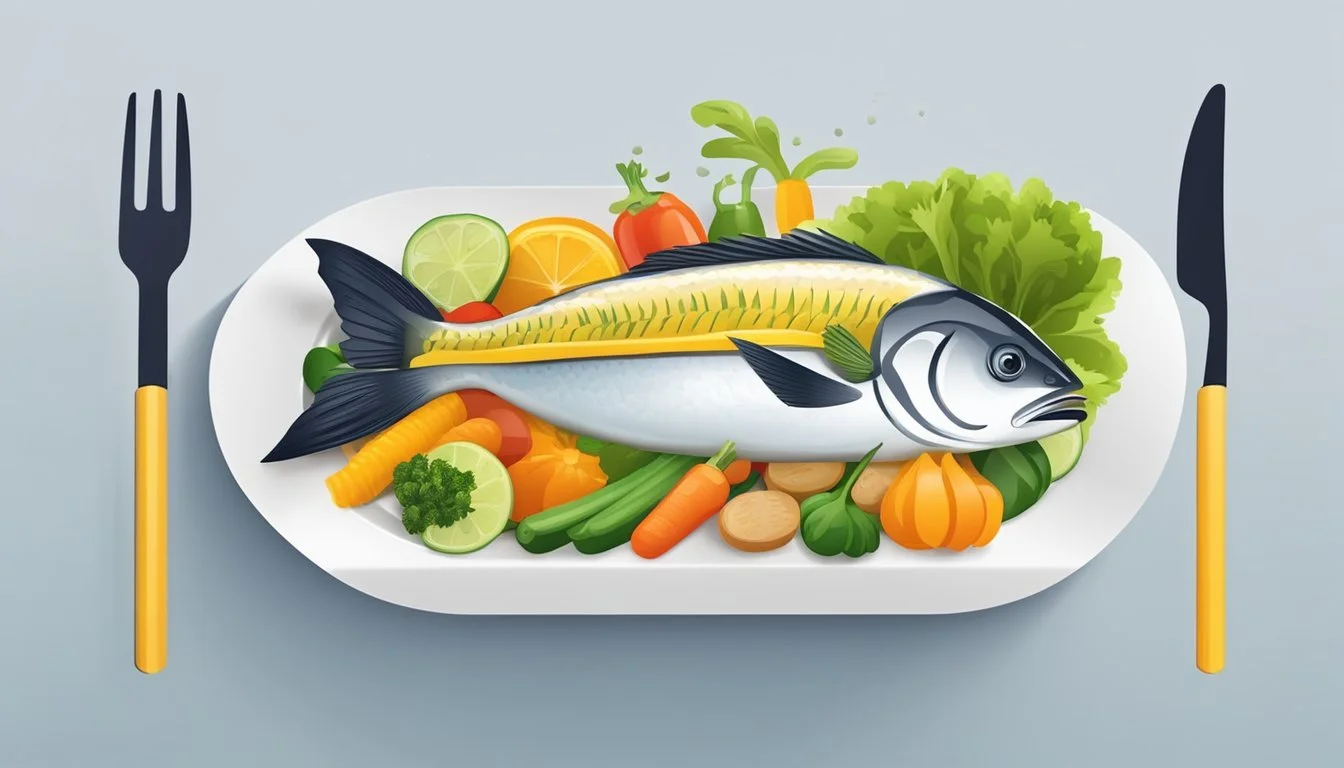Can Diabetics Eat Hoki?
Nutritional Insights and Health Benefits
Many people with diabetes wonder if they can include Hoki in their meals. This white fish, commonly found around New Zealand, is low in fat and rich in omega-3 fatty acids, which are beneficial for heart health. Hoki can be a suitable option for diabetics due to its high protein content and low carbohydrate levels, making it a great addition to a balanced diet.
When managing diabetes, it is essential to choose foods that help maintain stable blood sugar levels. Hoki's healthy fats and lean protein contribute to this, providing a filling yet low-carb protein choice. The American Diabetes Association recommends incorporating fatty fish into a diabetic meal plan for these reasons.
Incorporating Hoki into a diabetes-conscious diet can be simple and flavorful. Grilled, baked, or poached Hoki paired with non-starchy vegetables offers a nutritious and satisfying meal. Given its nutritional profile, Hoki stands out as a fish that can enhance a diabetic diet while supporting overall health.
Understanding Diabetes and Dietary Needs
Diabetes management requires careful attention to diet. Blood sugar levels are a primary concern. Consuming meals that balance carbohydrates, protein, and fat can help keep blood glucose in check. Monitoring carbohydrate intake is crucial since they have the most immediate impact on blood sugar.
Carbohydrates should be varied and include quality options. Fiber-rich foods are beneficial as they slow sugar absorption. Non-starchy vegetables, whole grains, and legumes are good choices. Limiting simple sugars found in sweets and processed foods can prevent spikes in blood glucose.
Protein and fat play important roles. Including lean protein sources like fish, poultry, and plant-based options supports muscle health. Healthy fats from nuts, seeds, and avocados offer satiety and nutrient absorption. Portion control and meal timing also influence blood sugar management.
A1C levels and insulin resistance are critical markers monitored by healthcare providers. Regular checks can guide dietary adjustments. Working with a dietitian can provide personalized meal planning. This professional guidance is recommended by the American Diabetes Association.
Calories matter, especially for those managing weight alongside diabetes. Maintaining an appropriate caloric intake aids in preventing complications. Managing type 2 diabetes often involves combining dietary changes with physical activity to increase insulin sensitivity.
In summary, a balanced approach to eating, focusing on whole foods, and professional guidance is essential for diabetes management.
Nutritional Profile of Hoki Fish
Hoki fish offers a rich source of essential nutrients that are beneficial for maintaining health. It is particularly noted for its high protein content and valuable omega-3 fatty acids, which support heart health and reduce inflammation.
Protein Content in Hoki
Hoki fish is an excellent source of protein, providing around 17 to 20 grams per 100-gram serving. Since protein is crucial for muscle repair and overall body function, incorporating hoki into a diet can be especially beneficial for those looking to maintain or improve their protein intake.
Fat Quantity and Quality
Hoki contains approximately 2 grams of fat per 100-gram serving. This fat content includes essential omega-3 fatty acids like EPA and DHA amounting to around 200 milligrams, which are beneficial for heart health and reducing inflammation. Notably, hoki is low in saturated fat, making it a healthier option compared to other fish.
Vitamins and Minerals Present
Hoki fish is rich in several essential vitamins and minerals. It contains significant amounts of vitamin B12, which supports nerve function and the production of red blood cells. Additionally, hoki provides selenium, an antioxidant that helps protect cells from damage, and iodine, important for thyroid function.
Caloric Information
A 100-gram serving of hoki fish typically contains about 90 to 100 calories. This makes it a low-calorie option, suitable for various dietary plans, including those focused on weight management. Its low-calorie content coupled with high nutritional value makes it an excellent choice for a balanced diet.
The Impact of Hoki on Blood Sugar Control
Hoki, a white fish found mainly in the waters around New Zealand and Australia, can be a beneficial addition to the diet of individuals managing diabetes.
This fish has a low glycemic index, meaning it causes a slow and steady rise in blood sugar levels rather than a sharp spike. Foods with a low glycemic index are important for maintaining stable blood sugar levels.
Hoki is rich in protein, which helps slow the absorption of sugar into the bloodstream. This can lead to more stable blood sugar levels, which is crucial for those looking to manage their A1C levels effectively.
Hoki also provides omega-3 fatty acids. These healthy fats can help reduce inflammation and improve insulin sensitivity, making it easier for the body to manage blood sugar levels.
Dietitians often recommend incorporating a variety of low-GI foods into one's diet to help manage diabetes. Hoki can be part of a balanced diet that supports overall blood sugar control.
Including Hoki in meals can aid in achieving a more balanced and controlled diet, beneficial for anyone managing their blood sugar levels and working towards better A1C readings.
Health Benefits of Including Fish in a Diabetic Diet
Including fish in a diabetic diet can provide multiple health benefits. Fish consumption helps support heart health, aids in weight management, and reduces inflammation and insulin resistance.
Heart Health and Diabetes
Fish, especially fatty varieties like salmon and sardines, are rich in omega-3 fatty acids. These fats help lower cholesterol levels and blood pressure, reducing the risk of heart disease, a common concern for diabetics. Omega-3s also enhance the flexibility of blood vessels and decrease plaque buildup within arteries.
Eating fish at least twice a week provides essential nutrients that support cardiovascular wellness without adding significant saturated fats, which can be harmful. Replacing red meat with fish further reduces the intake of harmful fats, contributing to better heart health.
Weight Management Strategies
Fish is an excellent source of high-quality protein, which promotes a feeling of fullness and reduces overall calorie intake. Low-calorie fish options like cod and tilapia can be particularly beneficial. Consuming fish can help diabetics control their weight, important for managing blood sugar levels and preventing complications.
The lean protein in fish supports muscle maintenance and repair, crucial for an active lifestyle. Eating fish regularly, paired with a balanced diet and exercise, supports sustainable weight loss or maintenance, making it easier to manage diabetes effectively.
Reducing Inflammation and Insulin Resistance
Fish high in omega-3 fatty acids, such as trout and mackerel, have anti-inflammatory properties. Chronic inflammation contributes to insulin resistance, a key issue in type 2 diabetes. By reducing inflammation, fish intake can improve insulin sensitivity and glucose metabolism.
Omega-3s help prevent the development of type 2 diabetes in predisposed individuals and mitigate complications in those already diagnosed. Regular fish consumption aids in maintaining steady blood sugar levels, an essential aspect of diabetes management.
In conclusion, incorporating fish into a diabetic diet offers numerous advantages, from improving heart health and aiding in weight management to reducing inflammation and insulin resistance.
Comparing Hoki to Other Protein Sources
Hoki fish offers a nutritious boost to a diabetic-friendly diet, especially when compared to other protein sources like poultry, meat, and plant-based options. Key differences include protein content, fat levels, and additional nutrients.
Hoki vs. Poultry and Meat
Hoki is lower in saturated fat compared to common poultry and meat options such as chicken breast, turkey, and pork. This makes it a heart-healthy choice. While chicken breast is a lean meat with around 31 grams of protein per 100 grams, hoki provides about 15 grams per 100 grams, complemented by beneficial omega-3 fatty acids.
Unlike pork and other red meats, hoki's omega-3s contribute to better cardiovascular health, a critical factor for diabetics. The fish also contains essential vitamins and minerals. This nutrient profile benefits those managing diabetes by supporting metabolism and reducing inflammation.
Hoki vs. Plant-Based Proteins
Hoki fish can be a more complete protein source compared to plant-based proteins like beans, lentils, and tofu. Beans and lentils offer around 9 grams of protein per 100 grams but lack certain essential amino acids that animal proteins provide. Tofu, similar in protein content to lentils, offers approximately 8 grams per 100 grams and contains all essential amino acids, yet lacks omega-3 fatty acids found in hoki.
The presence of omega-3s in hoki supports anti-inflammatory properties and aids in managing diabetes-related complications. Many plant-based proteins also come with additional carbs, affecting blood sugar control, whereas hoki provides protein and healthy fats with minimal carbohydrates. This makes hoki a valuable component of a well-rounded diabetic diet.
Addressing Common Concerns: Mercury and Toxins
Many people worry about mercury in seafood. This is especially relevant for those with conditions like type 2 diabetes. The National Institute of Diabetes and Digestive and Kidney Diseases (NIDDK) notes that a balanced diet is crucial for managing diabetes.
Hoki, a fish often found in cold waters, is generally low in mercury. This makes it a safer option compared to other seafood such as swordfish or shark, which have higher mercury levels.
In addition to mercury, other toxins like lead, cadmium, and copper are also concerns. These metals can accumulate in fish and pose health risks. Research indicates that high-quality diets can mitigate some of these risks, although exposure remains a concern.
The information from recent studies highlights the need for further research on mercury's role in chronic conditions like diabetes. For those managing diabetes, it’s crucial to choose fish with low mercury levels and high nutritional value.
Summary Table: Hoki and Mercury Levels
Fish Type Mercury Level Suitability for Diabetics Hoki Low Generally Safe Swordfish High Not Recommended Shark High Not Recommended
Regular monitoring and moderation are essential. Always consult with healthcare providers or dietitians for personalized advice. While Hoki is a good choice in terms of mercury levels, it’s important to maintain a varied diet to ensure comprehensive nutrient intake.
Meal Planning and Cooking Tips for Diabetics
Creating balanced and nutritious meals is essential for effective diabetes management. Here, specific tips for cooking and incorporating Hoki, a lean white fish, into a diabetic-friendly diet are outlined.
Healthy Cooking Methods for Hoki
Hoki can be prepared using several healthy cooking methods to maintain its nutritional benefits and keep it diabetes-friendly. Grilling, steaming, and baking are excellent options as they require minimal added fat.
Grilling: Use a non-stick grill and brush Hoki with a small amount of olive oil. Season with herbs and spices like dill or lemon pepper.
Steaming: Place Hoki in a steamer basket over boiling water. Add slices of lemon and fresh dill for enhanced flavor.
Baking: Wrap Hoki in parchment paper with vegetables such as zucchini, cherry tomatoes, and bell peppers. Bake at 350°F (175°C) for 15-20 minutes.
These methods preserve the fish's flavor while ensuring a healthy, low-fat meal option.
Incorporating Hoki into Balanced Meals
Hoki can be a vital component of a balanced diabetic meal when paired with vegetables, whole grains, and legumes.
Vegetables: Serve Hoki with a side of non-starchy vegetables like broccoli, spinach, or a mixed green salad. These provide essential vitamins and fiber.
Whole Grains: Pair Hoki with a serving of quinoa, brown rice, or barley for an added source of fiber and nutrients. Use portion control to meet dietary needs.
Legumes: Combine Hoki with a chickpea or lentil salad. This adds protein, fiber, and essential minerals which are beneficial for managing blood sugar levels.
Consultation with a dietitian can further tailor these meal plans to individual dietary needs, ensuring complete and balanced nutrition.
Integrating Hoki into meals can thus contribute to a varied and diabetes-friendly diet. The key lies in thoughtful meal planning and using healthy cooking methods.
Recommendations and Serving Sizes
Hoki is a beneficial choice for diabetics due to its low carbohydrate content and high levels of protein and healthy fats.
When considering portion control, a standard serving of cooked Hoki is about 3 ounces. This serving size balances calorie intake and ensures adequate protein without overindulging. While maintaining protein intake, such portions can help manage blood sugar levels effectively.
Nutritional Breakdown (per 3-ounce serving):
Calories: Approximately 90-100
Protein: Around 20 grams
Fat: About 1 gram
The American Diabetes Association recommends careful portion control for all foods, including fish like Hoki. Ensure servings are consistent with daily nutritional goals to avoid blood sugar spikes.
Incorporate Hoki into balanced meals, pairing it with non-starchy vegetables and whole grains. Avoid adding high-calorie, sugary sauces. Instead, use herbs and spices to enhance flavor without unnecessary calories.
Using this approach makes Hoki a practical and nutritious inclusion in a diabetic diet, supporting both blood sugar management and overall health.
Consulting a Healthcare Professional
Consulting a healthcare professional is crucial for diabetics considering adding Hoki to their diet. Registered Dietitians (RDs) can provide personalized nutritional advice, ensuring the fish fits into a balanced meal plan.
For individuals with type 2 diabetes, monitoring A1C levels is a key aspect of managing their condition. A dietitian can help determine how Hoki, rich in omega-3 fatty acids, impacts blood sugar and overall health.
It's important to discuss any dietary changes, like including Hoki, with your healthcare provider. They can advise on portion sizes and frequency, considering your blood sugar monitoring results.
Using tools like a blood glucose meter, patients can track how new foods affect their glucose levels. Immediate feedback helps adjust dietary plans as needed.
Follow-up appointments with dietitians or endocrinologists ensure that changes to the diet, including Hoki, are beneficial. This collaborative approach promotes better diabetes management and overall well-being.
Benefits of Consulting Healthcare Professionals:
Personalized advice
Monitoring impact on A1C and blood sugar levels
Safe integration of new foods into the diet
Remember, professional guidance helps make informed choices about your diet, especially when managing diabetes.











